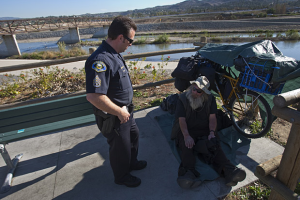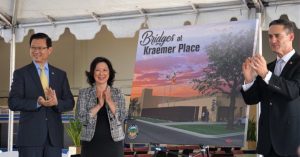.
.
.
 When the proposal to place a homeless shelter near my Rio Vista neighborhood was announced, concerns and objections soon emerged. The shelter had already been rejected by Santa Ana and Fullerton, and its original location had been changed from the centrally located Karcher site to the border between the cities of Anaheim and Orange. Kraemer is in a commercial and industrial area, and two neighborhoods from these cities, the Rio Vista and Riverdale are within a reasonable walking distance from the shelter.
When the proposal to place a homeless shelter near my Rio Vista neighborhood was announced, concerns and objections soon emerged. The shelter had already been rejected by Santa Ana and Fullerton, and its original location had been changed from the centrally located Karcher site to the border between the cities of Anaheim and Orange. Kraemer is in a commercial and industrial area, and two neighborhoods from these cities, the Rio Vista and Riverdale are within a reasonable walking distance from the shelter.
The homelessness crisis had not been felt in my neighborhood until the vacant Ralphs’ market building became a gathering spot for homeless individuals. The few close earlier experiences with homelessness had been when the housing market crash left an evicted family’s furniture in the front yard, the mentally disturbed neighbor who opted to live in the streets, and a fellow who spent his entire days in the nearby library.
The Riverdale neighbors may have had a much closer and frequent encounter with homeless living in the river. The death of four homeless persons – one of them, John Berry, a Vietnam War veteran – by a serial killer in 2011-2012, was a tragic indication that the crisis was not only a phenomenon in the downtown areas of the cities and involved people who did not fit the homeless stereotype. John Berry, in addition of being a veteran, was considered a very spiritual person, apparently not suffering from drug or substance abuse, or mentally disturbed. Mr Berry was killed by another veteran, from the Iraq war.
 In the neighbors’ reaction to the proposed shelter there was an underlying fear of having something like LA’s Mission, attracting drug addicts/substance abusers/mentally disturbed homeless overflowing into the residential areas. This fear was stressed by some of the opposition to the shelter, overshadowing the legitimate concerns of the neighbors.
In the neighbors’ reaction to the proposed shelter there was an underlying fear of having something like LA’s Mission, attracting drug addicts/substance abusers/mentally disturbed homeless overflowing into the residential areas. This fear was stressed by some of the opposition to the shelter, overshadowing the legitimate concerns of the neighbors.
This approach taken by elected officials, at the county and city level, and by most advocates, didn’t help. Based on the lessons of the previous rejections, the strategy implemented included the strong support of faith-based organizations, from the classical Catholic charities, from Unitarians to the more conservative mega-churches, and to ignore and pay lip service to the requests of the neighbors to be included in the plans to establish the shelter.
The shelter opened May 5th, and I don’t think that many neighbors were invited to the opening ceremony. A community meeting was held on May 16th, and not too many neighbors attended. Advocates, mostly not from the impacted neighborhoods, took most of the Q&A time. The meeting was held in a local church, in contrast with most of the community forums when the shelter was being proposed, which took place in churches far from our neighborhoods.
 The current operation of the shelter addresses most of the concerns of both business owners and neighbors. The business owners are pleased so far, although they still feel negatively impacted in the long term if they try to sell their property. They have made this point since the beginning that the values plummeted by having a shelter, not matter how well managed. The tight design and operation of the shelter has strict policies. Gabriel San Roman described the limitations of these policies and the history on enacting the shelter in this article.
The current operation of the shelter addresses most of the concerns of both business owners and neighbors. The business owners are pleased so far, although they still feel negatively impacted in the long term if they try to sell their property. They have made this point since the beginning that the values plummeted by having a shelter, not matter how well managed. The tight design and operation of the shelter has strict policies. Gabriel San Roman described the limitations of these policies and the history on enacting the shelter in this article.
The goal is to significantly reduce or eliminate homelessness, and how to accomplish that is an open, ongoing question. We react based on so many factors, and tend to simplify the problem and solutions, such as considering using unused or under-utilized public spaces like the ARTIC station as a temporary shelter during inclement weather. The camping ordinance puts again the needs of this vulnerable population at odds with the residents’ concerns. As we debate the legality and feasibility of actions, human lives in our own backyards are exposed to conditions not associated with wealthy nations.
 It has been a challenge already for the shelter’s operator to maintain the shelter as designed. They report that an agency has already tried to bring a person from one of the cities not covered by them. It is more of a challenge for all of us to address the needs of the overwhelming homeless population. The Board of Supervisors has proposed that a couple more shelters are needed in other areas of the county, that affordable housing is a required component of a reasonable solution. Whether this will make Orange County a magnet for out-of-town folks is another open question. One advocate at the meeting stated that it is a myth that homeless people migrate on their own to places with services for them. It has been reported that a hospital from a another State was inquiring whether the Santa Ana Courtyard would accept one of their discharged patients.
It has been a challenge already for the shelter’s operator to maintain the shelter as designed. They report that an agency has already tried to bring a person from one of the cities not covered by them. It is more of a challenge for all of us to address the needs of the overwhelming homeless population. The Board of Supervisors has proposed that a couple more shelters are needed in other areas of the county, that affordable housing is a required component of a reasonable solution. Whether this will make Orange County a magnet for out-of-town folks is another open question. One advocate at the meeting stated that it is a myth that homeless people migrate on their own to places with services for them. It has been reported that a hospital from a another State was inquiring whether the Santa Ana Courtyard would accept one of their discharged patients.
Neighbors from the city of Orange are reporting an increase of mini-camps near the river. I hope that their concerns and the needs of the homeless in that area are addressed, by not following the idea still proposed by one of their neighbors:
“My solution is that the Counties work together, as they did to decide to put this shelter where it is now….and find a place with inexpensive rural land. Put up a kibbutz like they have in Israel. “
Well-written and reported, Ricardo.
Good even handed summary. Only time will tell wether the County, Anaheim and other government entities will manage the shelter as advertised. I was also surprised that the public meeting was held in a church in lieu of the public library located just a few blocks away. I think there is a message? A signal that our local government is planning to keep the shelter operation results low key and hidden from view as much as possible.
The story has just begun. Lets give it a few months and then revisit the new homeless rehabilitation process that was described during the meeting.
Very good article. Thanks for the perspective coming from the point-of-view of a resident from a neighborhood that was mostly opposed to the shelter.
Thanks for sharing a goal of reducing or eliminating homelessness not only for the sake of persons’ experiencing homelessness but also for our communities.
In the event that I am ever involved again in the discussion about a future facility for the homeless, I’m going to look you up and call on you for advice. You have a great attitude.
Don’t feel sorry that you didn’t get an invite to the official grand opening of the shelter because myself and others who worked hard to get the shelter approved, didn’t get invited either.
The excuse I was given by a county staffer was that it was not a celebration since the county still had much work ahead and at least two more facilities were needed immediately in other areas of the county.
I did not get the sense of urgency from the recent excuse that I felt when the county first approved the Kraemer site, but then it took the county over 18 months to finally open the doors, so I don’t get as excited as before.
Thank you Mr Houchen. My humble advice would be to engage the neighbors in a positive way, especially when the outcome had already been predetermined. I salute you and all others who worked hard to get the shelter approved. I’m interested to hear your experience in doing so. I tried to understand the background of this process in this post:
http://www.orangejuiceblog.com/2015/08/oc-homelessness-anaheim-residents-reaction-confirms-the-shelter-model-needs-to-be-revised-part-ii/
The issue for some of us, was not so much the uncertainty of having a LA Mission type of shelter, but whether an institutionalized shelter, is the way to end a situation that should not be permanent. It may sound academic, as there is an obvious need to provide shelter, but the way how is provided, such as permanent vs temporary, has policy implications.
With all due respect, I wonder whether it was your decision or the blog’s publisher, to throw in the NIMBY word in your recent post on the county’s budget. It is an over-simplification and doesn’t help to create goodwill and acceptance to do our share to address the problem.
Neighbors had opposed the Taboo totally-nude strip joint years before the shelter became an issue. The permit allowed by the county I believe, for the strip joint, was interpreted as an indication that our neighborhood and the surrounding areas were not considered prime ones. The shelter proposal was taken along the same lines. One of the restrictions of the shelter, no allowing families with children, it is because of the close proximity to the strip club. I invite you to read this post:
:http://www.orangejuiceblog.com/2015/05/council-to-neighbors-of-anaheim-canyon-we-will-take-the-credit-you-will-take-the-burden/
The neighbors’ debate has mostly shifted from the shelter to the riverbed camp. Some of the most critical neighbors seem to be new to the issue, and they’re going through the process of planning to address the board of supervisors and city councils. This is a snip of the discussion taking place in a social media:
” Many of us are trying to get the homeless camps off the riverbed and Todd Spitzer wants to install toilets for them. When are we going to vote this guy out of office?
Kevin from Anaheim – Rio Vista · 2d ago
Our city is going downhill due to the influx of homeless and the crime they bring, and the guy who is suppose to be looking out for interest keeps making the problem worse:
http://www.ocregister.com/2017/05/23/sup…
Neighbors, just my opinion, but this guy is not a friend. He’s not looking out for us, our neighborhood or our property values.
Edited 2d ago · Shared with Anaheim – Rio Vista + 34 nearby neighborhoods in Crime & Safety”
Sal from Lincoln Rio Vista · 2d ago
I would rather them use these portable toilets then to defecate along side the riverbed. Now, is this going to stop them from living there absolutely not. If your homeowner in the 92806 area code and pay taxes and love your city you need to realize this a serious problem and we ALL then to do our part to get our city back instead of pointing our finger. Maybe you feel compassion which is humane but what if one day, you are the victim of a crime committed by one of these individuals how would you feel then. Unfortunately there is so many of them, not all are just homeless its fair to say some are on drugs and are criminals. Anaheim has always had homeless people but nothing like this. This homeless problem has already increased crime it’s a fact and I want to avoid being the next victim. So the big question is how do we solve this problem? All I know is Yorba Linda does not have this problem or Brea or many other cities so why us?
Kevin from Anaheim – Rio Vista · 2d ago
Sal, I agree with a lot of what your saying here. In the future we will be moving to Yorba Linda or Anaheim Hills into a gated community, precisely for the reason you mentioned.
For now though, we’d like to do everything we can to improve this neighborhood, and make this the best place it can be for those who live here, pay taxes and contribute.”
katharine from Anaheim – Rio Vista · 1d ago
Many homeless people are the original victims of abuse, crime, addiction and mental health issues, things that many of us can be affected by, or have our family members affected by. There is not an abundance of shelters, especially not “housing first” shelters. Basically, the problem is not as simple as it seems to me that you think it is, or that you think it should be. I do not think your experiences with the homeless should stereotype them as “lazy” or “criminal.” I am worrying about helping them and the value of my soul, not only my property’s value. “
I was at the townhall meeting and I received an impression other than, “It has been a challenge already for the shelter’s operator to maintain the shelter as designed. They report that an agency has already tried to bring a person from one of the cities not covered by them.” While true that the operator stated two agencies, one a hospital and one a coastal police department, tried to drop off unvetted persons, the operator successfully declined the admission. The operator shared the anecdote to say that they were operating as designed and staying within the parameters and mission statement of the enterprise.
That being said, I was against the “shelter” and wrote letters to the Orange City Council and Supervisors. I reside in Riverdale, a block from the River, and have seen the growing homeless population between the 91 and Lincoln along the trail. However, I need to say that the County did a terrible PR job concerning the “shelter”. As it turns out, it is actually more of a transition center designed to get those people that want to be off the streets into permanent housing.
I was afraid it would be a walk up shelter like the armorys and be a magnet for more homeless along the River, but think we dodged the bullet on this one. I’ve had a chance to visit the facility and I am very impressed with the operation and the staff.
It seems as if the people along the river near us are not inclined to go into a shelter situation where they need to follow rules and adhere to standards. I’m quite concerned about the growing situation and look forward to being kept informed.
I see your point. Mine was meant in the broader sense that it is going to be a new challenge to maintain the operation within its parameters and mission statement. The pressure to allow some of the population not ready for permanent housing may eventually require some adjustments, if no additional places are set up within a reasonable period of time.